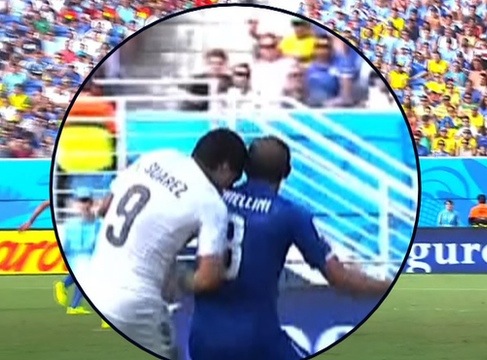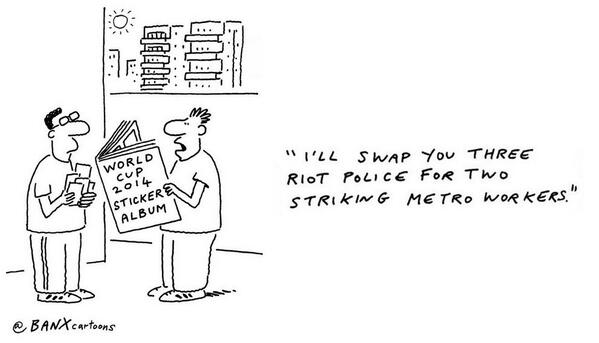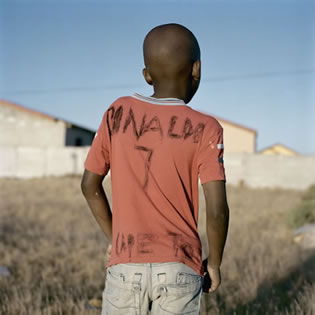Thabiso “Boyzzz” Khumalo grew up in Soweto, South Africa, around the corner from the homes of two Nobel Peace laureates: Nelson Mandela and Archbishop Desmond Tutu. Like so many boys in the land of apartheid, he spent every moment of free time playing soccer and dreaming of becoming a professional player overseas. Unlike most of them, however, Boyzzz fulfilled his dream
On July 22, I sat down with Boyzzz for an interview on the campus of Michigan State University. We’d been hoping to do an interview ever since we met in November 2013 when he visited my “Sport in African History” seminar for a screening and discussion of Invictus.
This week was an especially opportune time to chat about Boyzzz’s sporting life because on Sunday, July 27, Lansing United, his current team, travels east to New Jersey to play a National Premier Soccer League semifinal against New York Red Bull Under-23.
How does a young man from Soweto end up playing in Michigan? In part 1 of our interview, Boyzzz shares memories of anarchic pickup games in Soweto; his first experience in the U.S. during a youth tournament that would change his life; and then scoring his first MLS goal for DC United.
Boyzzz also discusses the work of the Umhlaba Vision Foundation–a nonprofit organization he founded in 2007 with two South African friends. The goal of Umhlaba (meaning “world” in the Zulu language) is to change the lives of young Sowetans by creating a positive development environment through sport and education and bringing student-athletes to the United States. For more information about the foundation please email Boyzzz (boyzzzkhumalo80 AT gmail).
Don’t forget to come back tomorrow for part 2 of the interview!
Author: Peter Alegi
I chatted about the 2014 World Cup with Assumpta Oturu on KPFK Pacifica Radio‘s Spotlight Africa program.
We analyzed Brazil’s historic collapse, Germany’s youth development policies, club versus country loyalties, African teams’ performances and what can be done to improve their results in global football.
Listen to the entire July 19, 2014, show here.
Radio talk show host, author, and political analyst Eusebius Mckaiser spoke with Robin Petersen, CEO of the South African Football Association’s development agency, about what is going wrong and what needs to be done about the future of Bafana Bafana—the South African men’s national team.
Peterson has an unusual background for a South African football administrator. He owns a construction company and holds a PhD in Religion and Ethics from the University of Chicago Divinity School. Since 2001, Peterson has held important positions, including as CEO of SAFA and the domestic Premier Soccer League. In his new role at the helm of SAFA’s Development Agency, Peterson’s job is to ensure that the football development plan known as SAFA Vision 2022 is implemented.
In conversation with Eusebius and his listeners, Petersen touches in general terms on a 7-point plan that includes a national football philosophy; youth teams and academies; coach education; football infrastructure; and sports science. The complete absence of a sense of history in his remarks underscores a serious problem within South African football: an unwillingness to deal honestly and productively with what has already been said, tried, and failed in the two decades since the end of apartheid and the birth of democracy. (For two different, but complementary, critiques of South African football development, click here and here).
Despite Petersen’s best intentions and SAFA’s more sophisticated packaging, it seems that, once again, the latest development plan amounts to little more than a public relations campaign.
Struggling Italy Robbed at the World Cup

36 hours have passed since millions of Italians watched the national team get eliminated from the World Cup after a 1-0 loss to Uruguay.
Here in Italy, the media and the pundit class have joined ordinary fans in criticizing the team. First in the line of fire is Cesare Prandelli, the coach, rightly taken to task for dubious roster selection, poor match management, improvised tactical changes, and an inability to bind together a group of “senators” (i.e. veterans) and relatively inexperienced youngsters. His resignation in the aftermath of the Uruguay loss, came not a moment too soon for many Italians.
Balotelli, the only player in the squad with potential to be a game-changer, has also come in for plenty of criticism. Reading the papers, watching endless debates on TV, and talking with fans, it appears that many Italians, including vocal defenders of Super Mario, are disappointed with the star striker’s weak performance. Sadly, some racist Italians have taken to the web and social media to insult Balotelli for his blackness.
But I wouldn’t go so far as saying that Balotelli is being blamed for the World Cup debacle. Honest observers recognize that the failure of Italy’s 2014 World Cup campaign has multiple causes, not least the pathetic 0-1 loss to Costa Rica last week. As historian John Foot explained in an excellent column, there is a structural rot in Italian football that needs to be addressed. From corruption and mismanagement to suffering youth systems, club rivalries, and outdated stadiums; the list of major problems is quite long and vexing.
While this analysis is legitimate, there seems to be a consensus among Italians (and not a few neutrals) that the loss to Uruguay was an outright robbery perpetrated against an ordinary team.
The first half of Tuesday’s match was played evenly, with Italy rarely in trouble. Pirlo had a dangerous free kick saved by Muslera and Verratti distinguished himself as the best player on the pitch, weaving in and out of Uruguay’s workman-like midfield with creativity and dynamism. With a draw enough to see the Azzurri through to the next round, Italy was in control.
Then, a few minutes into the second half, the Mexican referee, Rodriguez Moreno, decided the match. In an inexplicably absurd decision, he sent off Marchisio with a straight red card for a normal tackle that showed no malice and, at best, deserved a yellow. What made this refereeing decision so outrageous is that previous Uruguayan fouls of a similar ilk had not been punished with any cards.
Moreno’s call transformed the match. With nearly the entire second half still to play in the heat of Natal, the Azzurri were a man down, less able to deal with fatigue, and psychologically shaken. Uruguay, on the other hand, seized on the opportunity and began dominating the match. Even so, only two goal-scoring chances came out of this advantage.
Perhaps dissatisfied with the outcome of his earlier outrage, Moreno then took center stage again. Suarez, the recidivist, sunk his fangs into Chiellini’s shoulder and then fell to the ground, theatrically, as if felled by a sniper’s bullet. The referee awarded a free kick to Italy, but did not send Suarez off despite Chiellini showing Suarez’s dental mold chiseled into his shoulder area. Surprisingly, the assistant referee provided no assistance.
Two things happened at this point. Instead of playing the final 12 minutes or so 10 vs 10, the Azzurri had to labor on a man down with players cramping and visibly tiring. Then, 100 seconds after the Suarez bite, the Italians lost their concentration defending the corner kick that produced Godin’s winning goal.
Most Italians recognize the 2014 national team was an ordinary one. Fans and pundits admit that Balotelli, Immobile, Cassano, Thiago Motta, De Sciglio and others put in sub-par performances. But people also know a robbery when they see one. And the culprit was Rodriguez Moreno. Curiously, another referee named Moreno (from Ecuador) also sent the Italians home from the 2002 World Cup. He is currently serving a long prison sentence in the United States for smuggling drugs.
Brazil 2014: World Cup Politics
The day before the magic kingdom opens in São Paulo, WKAR’s “Current State” host Mark Bashore interviewed me about the politics of the World Cup. We discussed FIFA profits and institutional reform, special World Cup laws and extraterritoriality, nation-building, development, civic protests, and what the future holds for Brazil, on and off the pitch. Originally broadcast live on June 11, 2014. Take a listen!

World Cup Music: “Afri Can”
An antidote to Shakira and Pitbull!
“Afri Can” is a charity single by Replay GH, a Ghana-based group featuring Zed Ay Kay (Replay GH), Fuji, Farid, and Gustav. It brings together influence from the five African countries that have qualified for the Brazil 2014 World Cup: Ghana, Nigeria, Cameroon, Algeria, and Ivory Coast.
According to the artists, “the different influences, and styles are seamlessly woven together to produce a modern Afro Beats song for the enjoyment of all football and music fans.” To find out more about Afri Can, visit: http://www.outofafricacampaign.com/afri-can/
How Africa Developed Europe

African national teams in the 2014 World Cup will rely overwhelmingly on Europe-based players. Here are the exact numbers according to the preliminary lists recently released by FIFA:
Cameroon: 26 out of 28
Ivory Coast: 26 out of 28
Nigeria: 25 out of 30
Ghana: 25 out of 26
Algeria: 25 out of 30
The data reveal that nearly nine out of ten Africans likely to be in Brazil next month play for European clubs. 127 out of 142 players, or 89.4 percent, to be exact. Just over half (52.1 percent) of these players come from Big 5 leagues (England, Spain, Italy, Germany, Spain).
Four years ago, the percentage of Europe-based players in the final 23-man squads of the six African nations was around 80 percent (click here for data). This lower figure stemmed largely from South Africa’s use of players from its domestic Premier Soccer League, ranked among the Top 10 richest leagues in the world.
The 2014 numbers also reveal that nine of the fifteen Africa-based players on the preliminary lists are goalkeepers. In other words, a minuscule 0.42 percent of “outfield” players are on the books of African clubs.
The export of talent from Africa to Europe, as the academic research demonstrates, has produced winners and losers. In strictly economic terms, benefits accrue to individual players who make it into European football, as well as to African coaches, scouts, and other local stakeholders in this global commodity chain. But in the end the lion’s share of the financial rewards in this relationship go to European clubs and leagues, usually at the expense of the sustainability and quality of domestic leagues and clubs in Africa.
***
Addendum (4pm ET, May 23, 2014)
In response to @TonyKaron’s comment on Facebook about the similarities of Africa with Latin America, here are the numbers for foreign-based players on South American team lists:
Brazil: 19/23 (18 Europe, 1 Canada)
Chile: 19/26 (15 in Europe, 3 Brazil, 1 Mexico)
Colombia: 24/27 (18 Europe, 2 Mexico, 3 Argentina, 1 Brazil)
Uruguay: 24/25 (16 Europe, 1 Japan, 4 Brazil, 1 Argentina, 1 Paraguay, 1 Mexico)
Ecuador: 17/30 (5 Europe, 7 Mexico, 1 Colombia, 1 Brazil, 1 USA, 1 Saudi Arabia, 1 UAE)
Argentina: 22/26 (20 Europe, 1 Brazil, 1 Mexico)
Total: 125/157 (79.6 percent)
I also ran the Asia numbers:
Australia: 22/30 (17 Europe, 1 USA, 1 Japan, 1 S. Korea, 1 China, 1 Qatar)
Japan: 12/23 (all in Europe)
Iran: 10/30 (7 Europe, 1 Qatar, 1 Canada, 1 Kuwait)
South Korea: 17/23 (9 Europe, 4 Japan, 3 China, 1 Saudi Arabia)
Total: 61/106 (57.5 percent)